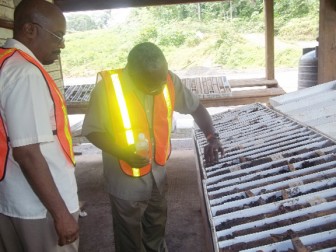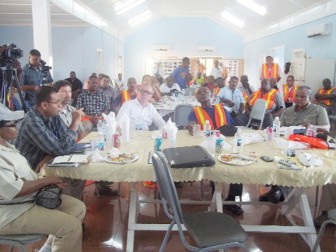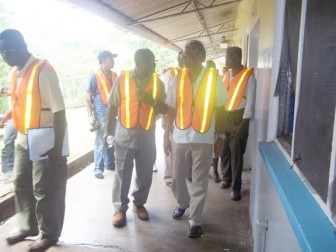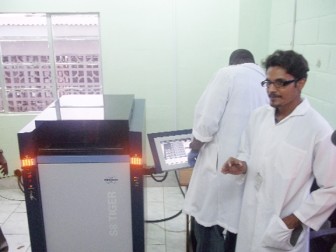Canadian mining company Reunion Manganese has expended some $1.7 billion in its two years of operation in the Matthew’s Ridge area, but the company laments the shortage of skilled personnel, including geologists, to man its operations.
The mining company has been working over the past two years to resuscitate the manganese mines at Matthew’s Ridge in the North West District, which were operated between 1962 and 1968 by Union Carbate. Reunion Manganese is at the moment undertaking critical tests of the area, with plans to produce the 4th most demanding metal on a large scale in the coming years.
Consultant to the company, Major General (Rtd) Norman McLean told stakeholders, including members of the government and the opposition as well as the diplomatic corps during a tour of the company’s operations yesterday, that the company has so far spent $743 million on wages and salaries while $619 million were spent on infrastructural development including on the roadway linking the area to neighbouring Port Kaituma, the airstrip as well as on the hospital in the community.

McLean said the firm had planned initially to build a health centre in the area but its administrators later considered and green-lit a plan to assist in the upgrading of the Matthew’s Ridge hospital which had been in an appalling state over the years.
Dr Grantley Waldrond, who is also consulted by the company given his experience and expertise, noted that the company has so far increased its testing for the mineral to 1,000 tests per day on three blocks of its prospecting licence (PL). The company aims to produce 2 million tonnes of (40%) manganese concentrate per year by 2014.

To date, the company has been carrying out work on 15 km of land, where 126 trenches have been dug in search of the mineral. Also, some 498 drill holes have been dug, Dr Waldrond noted. He said the results are encouraging for Reunion and works are being undertaken and results obtained according to plans. He explained that the drilling being undertaken by the company is aimed at confirming known zones for the mineral as well as the produce of material resources on Hills 1 to 4 of the 9 Hills being explored.
On Thursday, the company announced that its drilling programme confirmed the strike extent and vertical continuity of “significant manganese mineralisation” in four target hills of the Matthews Ridge Project. Further, it said widespread mantle-type mineralization in the weathered profile confirmed the “supergene enrichment of host rocks, amenable to simple earth-moving extraction” and that two new manganese occurrences with strike lengths of 300 to 400 m were discovered 2 km north of the former Matthews Ridge manganese mine area and that initial trenching at the westernmost discovery occurrence indicated multiple manganese beds.

Jo Bayah of Reunion said the company’s presence will bring significant benefits to the area. He said the firm is considering plans to move the mineral out of the area to Port Kaituma to the east, then to the Waini area then off to Trinidad where its market for the product lies. The Chief Operating Officer said considerable sums will be expended by the company in this regard but he noted that it will be to the benefit off all, including the economy and the company.
According to Bayah, several challenges including the shortage of skilled personnel have proven difficult for the company thus far. The company has under its employ, less than a dozen geological technicians and a limited number of geologists. He said the infrastructure in the area, mainly the roadways and the airstrip have also been in a difficult shape but the company has been working to address these with its own resources. The company has also encountered difficulties with the relevant public sector agencies, including customs.
Minister of Natural Resources and the Environment, Robert Persaud, said Reunion will “breathe life back to the region”. He said anticipation is rife as regards the company being up and running soon, adding that there is hope that many persons in the area will be offered jobs. He cautioned the entity to pay attention to the relevant environmental and social factors as it carries out its operations.
Persaud said government has encountered problems with prospecting licensees and has expressed disgust at the sloth with which those operations carry out their reconnaissance missions. But he noted that Reunion’s efforts in the past two years have been commendable.

Opposition Leader David Granger told the gathering that the project will bring benefits to the area and the nation as a whole and according to him, an opportunity is being made available by Reunion, “not only to produce manganese but to take a holistic look at developing the potential of the area, the education potential of the area and of the country as a whole.” As regards the latter, he said the university should be supported by projects to train and develop relevant personnel.
APNU MP and resident of the Matarkai sub-region Richard Alleyne queried yesterday whether the company had reached out to the people of the area. He said there were calls from residents for more information be made available to them.
Minister within the Local Government Ministry Norman Whittaker said too that the company should reach out to the Regional Democratic council (RDC), which was “not too involved.” He said, “there is need to have our local government body involved… to engage them and to update them on what is taking place.”
McLean said the company has been interacting with residents of the community and he refuted suggestions that residents would have to relocate from the community to make way for the project. “In fact we have never and I want anyone to come forward and say whether we have indicated that they have to move,” he said. McLean said he has been engaging residents at community level meetings, adding that considerations are being given to the use of agricultural projects being sourced from the area by the manganese firm.
Reunion Manganese has been working on 45,729 acres of land and has refurbished several facilities which were left behind by Union Carbate in 1968. The concentrate from the operation at Matthew’s Ridge will be shipped overseas to contribute to a vibrant market in which manganese, a core element of steel and iron products, is in rising demand worldwide. The company inked its mineral agreement with the government in March last year.




